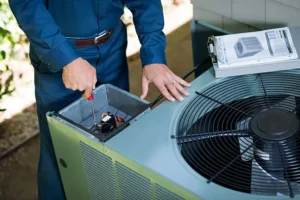In the chaotic aftermath of disasters, appliance repair services emerge as unsung heroes, working tirelessly to restore a sense of normalcy.
While immediate concerns often revolve around shelter, food, and medical aid, the role of appliance repair services emerges as a crucial element in the intricate tapestry of disaster recovery. This blog aims to illuminate the vital role these services play in the wake of calamity, exploring the complexities they face as they navigate the path to rebuilding and resilience.
Importance of Appliance Repair in Disaster Recovery
In the intricate dance of our daily routines, appliances take center stage, orchestrating the symphony of comfort, sustenance, and communication. Yet, when disaster strikes, their role transcends convenience to become indispensable for survival and the restoration of normalcy.
Refrigerators transform into the guardians of perishables, stoves metamorphose into culinary saviors, and washing machines assume the mantle of hygiene custodians. The functionality of appliances during the recovery phase directly influences the well-being and quality of life of those grappling with the aftermath.
The silent humming of appliances becomes a reassuring soundtrack, signaling the gradual return to a semblance of routine and normality.
Challenges Faced by Appliance Repair Services in Disaster Recovery
A. Infrastructure Damage
The aftermath of a disaster often leaves a trail of destruction, with infrastructure bearing the brunt of nature’s fury. Power lines dangle precariously, water supplies become contaminated, and gas systems suffer damage. These challenges create formidable hurdles for appliance repair services, hindering their ability to access affected areas and conduct repairs efficiently.
B. Resource Constraints
In the wake of a disaster, the demand for appliance repairs skyrockets, placing immense pressure on the available resources. Skilled technicians become a scarce commodity, and the procurement of replacement parts becomes a logistical puzzle. The gap between demand and supply stretches resources thin, testing the resilience of repair services.
C. Safety Concerns
Repair technicians operating in disaster-stricken regions navigate a landscape fraught with safety hazards. Unstable structures, exposure to hazardous materials, and unpredictable environmental conditions elevate the risks associated with their work. Addressing these safety concerns becomes paramount to ensure the well-being of both the repair professionals and the communities they serve.
D. Coordination and Logistics
The complexities of coordinating repair efforts in the chaotic aftermath of a disaster add layers of intricacy to an already challenging task. Collaboration with various stakeholders, including government agencies, relief organizations, and affected communities, becomes imperative. Streamlining logistics and communication is essential for a cohesive and effective appliance repair strategy.

Repair Strategies and Solutions
A. Emergency Repairs
In the aftermath of a disaster, the urgency of the situation demands a rapid and pragmatic response from appliance repair services. The deployment of swift and effective emergency repairs becomes a critical component in the overall recovery effort.
The primary goal of emergency repairs is to restore basic functionality to appliances. Whether it’s repairing a refrigerator to preserve perishable goods, fixing a stove to enable cooking, or ensuring a washing machine functions for hygiene purposes, these quick solutions address the most fundamental needs of disaster-stricken communities. They serve as a bridge between the immediate aftermath and the more comprehensive repairs that will follow.
The ability to cook a hot meal, preserve food, or maintain basic hygiene becomes not just a matter of convenience but a crucial element in the physical and emotional recovery of individuals and families.
While emergency repairs are vital for immediate relief, they are not meant to be permanent solutions. Instead, they serve as a temporary measure until more comprehensive repairs can be undertaken. This phased approach ensures that the most critical needs are addressed promptly, laying the groundwork for a more thorough and enduring restoration of essential appliances.
B. Resource Mobilization
Efficient strategies for acquiring essential repair resources are crucial during disaster recovery. This involves the strategic deployment of skilled technicians to the most critical areas, expedited procurement of replacement parts, and seamless coordination with suppliers and manufacturers. Resource mobilization ensures a more agile response to the overwhelming demand for repairs
C. Technician Training and Safety Measures
To navigate the unique challenges posed by disaster scenarios, technicians require specialized training. Emphasizing safety measures becomes paramount to protect both the skilled workforce and the vulnerable communities they serve. Training programs that address the specific hazards encountered in disaster-stricken areas equip technicians with the knowledge and skills needed for effective and secure repairs.
D. Collaboration with Relief Organizations
Effective collaboration between appliance repair services and relief agencies enhances the overall recovery efforts. By pooling resources, expertise, and logistical support, these partnerships contribute to a more comprehensive and impactful repair process. Coordinated efforts ensure that appliance repairs align with broader relief initiatives, creating a synergistic approach to community recovery.
Future Considerations
A. Lessons Learned
Reflection on past disasters provides invaluable insights into what worked and what can be improved in appliance repair services during disaster recovery. Lessons learned serve as the foundation for more effective disaster preparedness and recovery plans. Identifying areas that can be improved and making changes based on past experiences ensures a more adaptive and resilient response in future crises.
B. Technological Advancements
The landscape of appliance repair is evolving, and technological advancements hold the promise of revolutionizing repair services during disaster recovery. Innovations such as remote diagnostics, 3D printing of replacement parts, and automation have the potential to significantly enhance the efficiency and effectiveness of repairs in challenging environments. Embracing these technological advances positions appliance repair services at the forefront of resilience in the face of future disasters.
Conclusion
As we navigate the path to recovery, recognizing the importance of appliance repair services and addressing the challenges they encounter becomes integral to building resilient communities and fostering a quicker and more robust recovery from the ravages of disaster. For more information about appliance repair services, contact us today.





